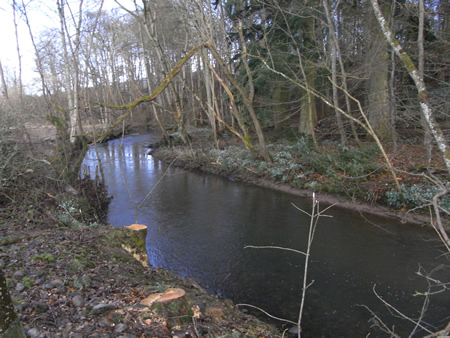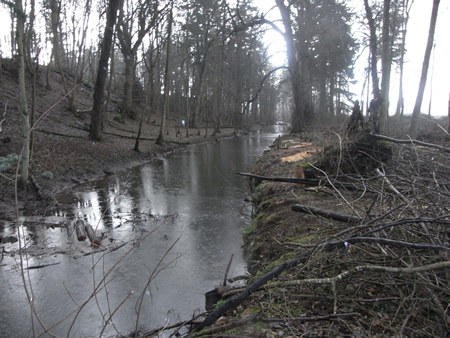These bulletin blogs represent news about Finavon and the South Esk, and my views as a riparian owner. They are not the views of any other organisation, nor are they designed to promote the interests of any individual or organisation other than Finavon Castle Water and factors affecting the fishery. Tony Andrews
After reading Bill Menzie’s report of 1957 I came away with the conviction that the South Esk’s tributaries are of more importance than I had thought to the capability of the river to regenerate its distinct populations of salmon and sea trout. This function applies as much to the catchment’s low ground burns as it does to those in the upper catchment. This is not to suggest that the main stem of the South Esk, especially downstream of its confluence with the Prosen, does not play a vital role in providing spawning habitat for summer and backend fish, and juvenile habitat for parr that have moved out of their native tributaries, as well as well as parr born in the main stem of the river. It is worth remembering that Menzies wrote his report at a time of strong runs of spring salmon and summer sea trout.
 This is the section of the Lemno Burn immediately upstream of the Red Brae confluence. The banks have recently been cleared of unthinned woodland that prevented light getting to the bed of the burn. Woody obstructions have also been removed from the bed of the stream, along with overhanging bankside vegetation. For the first time in at least 20 years the burn is now flowing freely which should start to clean its gravels and encourage increased spawning.
This is the section of the Lemno Burn immediately upstream of the Red Brae confluence. The banks have recently been cleared of unthinned woodland that prevented light getting to the bed of the burn. Woody obstructions have also been removed from the bed of the stream, along with overhanging bankside vegetation. For the first time in at least 20 years the burn is now flowing freely which should start to clean its gravels and encourage increased spawning.
The Lemno Burn is an important middle-river tributary of the South Esk which enters the River about 1000 yards downstream of the A90 bridge at Finavon. The Lemno flows through an intensively farmed section of the Vale of Strathmore where repeated unauthorised dredging over the years has been normal land management practice. The most recent of these dredging incidents took place in 2010/11 after considerable pressure was exerted by a farmer on SEPA officials who, apparently disregarding the SAC status of the S Esk and its tributaries, and in contravention of the letter and the spirit of the Controlled Activity Regulations, allowed a dredging operation on nearly a kilometre of the burn upstream of Bogindollo. The straightening of this already damaged water course smacks of the abuse of the Rottal Burn in Glen Clova. If you add the diffuse pollution from fertilisers and pesticides to the point pollution from roads run-off and slurry pits to the catalogue of abuse that the Lemno represents, it is not surprising that it is a poor performer spawning and juvenile-wise.
The Lemno a bit further upstream from the picture above. This section of the Lemno Burn used to include the lade from Tannadice Dam, which was demolished in 1946. The artificially wide channel has never had a chance to close up because of the lack of bank growth and consequent protection from erosion. This picture was taken immediately after the remedial forestry work was completed. A good spate should clear out the bed of the stream and start the long process of moving the silt and cleaning the gravels.
But how bad a performer is the Lemno? At present I don’t have the details (but I am working on that). Suffice to say that electro fishing of the Lemno up to Bogindollo reveals some salmon fry but very few parr, and those that were caught were (I quote an MSS scientist) “gigantic”. We can assume they have feasted well on fry. One of the problems of the burn in terms of juvenile salmon habitat is that there is very little riffle because of the woody dams holding back the water in a series of deep and slow moving pools, ideal for predators, including large parr. That problem may now be solved in the bottom section (downstream of the A90) after the remedial work completed in March 2012.
It is worthwhile comparing the shapes of the catchments of the North and South Esks. In the case of the former, the line drawn around the river’s watershed produces a shape not unlike a chestnut tree, with a short trunk and tributaries spreading widely as the full foliage of a mature chesnut tree does. The South Esk’s watershed shape by contrast looks more like a poplar tree with its long trunk and relatively few small branches. The confluence with the Prosen (or to continue the tree analogy, the fork in the poplar), the South Esk’s main tributary, is located in the upper third of the river catchment, some 28 miles from the sea. The shape of the North Esk’s catchment is similar to that of Tweed, where good-sized tributaries flow through fertile and relatively low ground glens to form a chestnut tree shaped catchment. In terms of the ‘wetted area’ available as nursery habitat, Tweed and North Esk provide better facilities for young salmon than the South Esk, and that is reflected in their relative abundance of salmon.
Until about ten years ago sea trout were the South Esk’s dominant species. It may well be the case that the trend of fewer spring salmon and the increase in autumn salmon has displaced sea trout from their spawning and juvenile areas. Certainly, the ratio of salmon to sea trout has changed noticeably in the last few years. In the longer term, species identification and genetics should help us understand whether this thesis is defensible.
As Menzies points out, the tributaries of the South Esk and Prosen are crucial in regenerating salmon and sea trout. The fact that the South Esk depends so heavily on its tributaries, and that there are so few of them, means that we need to value every yard of every tributary, from Pow Burn to Noran, Melgund, Lemno, White Burn, Carity, Moy and all the other tributaries above the Meetings. We should pay attention to the detail of managing these precious streams and of monitoring their outputs of parr/pre-smolts. That means more measuring – boring, but essential groundwork of accurate and effective fishery management.
TA 5/3/2012
